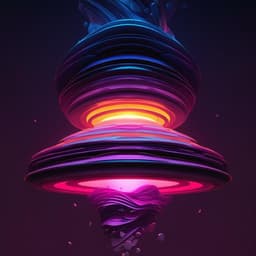
Physics
Highly efficient polaritonic light-emitting diodes with angle-independent narrowband emission
A. Mischok, S. Hillebrandt, et al.
Discover groundbreaking research by Andreas Mischok, Sabina Hillebrandt, Seonil Kwon, and Malte C. Gather, revealing a novel approach in organic light-emitting diodes (OLEDs). This study introduces an 'assistant strong coupling layer,' achieving angle-independent narrowband emission with astonishing efficiency and high luminance. A must-listen for anyone interested in the future of display technology!
~3 min • Beginner • English
Introduction
The study addresses how to achieve electrically pumped, narrowband light emission that is stable with viewing angle, a key requirement for displays, sensors, and imaging. Conventional organic and perovskite emitters exhibit broad spectra due to disorder; microcavities can narrow spectra but introduce strong angular dispersion. Strong exciton–photon coupling in microcavities forms exciton–polaritons that offer desirable properties and could mitigate angular dispersion, yet prior polaritonic OLEDs have suffered from very low efficiencies and brightness. The authors propose and demonstrate a design that decouples light generation from polariton formation by adding an assistant strong-coupling layer at a field maximum in a microcavity OLED, aiming to retain high OLED efficiency while producing angle-stable polariton emission.
Literature Review
Prior polariton LEDs using GaAs were limited by weak exciton binding and cryogenic requirements. Organic semiconductors support room-temperature polaritons, and room-temperature polariton OLEDs have been shown, but required strongly absorbing bulk emissive layers with low photoluminescence quantum yield, resulting in very low EQE and brightness. Proposed efficiency improvements included coupling inorganic and organic resonators and radiative pumping of polaritons; however, reported EQEs for single-cavity and weak–strong coupled architectures remained low (~0.2% and ~1.2%, respectively), whereas weakly coupled microcavity OLEDs routinely exceed 20% EQE. For angular color stability, weakly coupled MC OLEDs narrow spectra but suffer strong angular dispersion and visible color shifts; mitigation via external or internal scattering or other cavity designs mixes angular components but broadens spectra and reduces color purity. These limitations motivate a polaritonic approach that achieves flat, exciton-like dispersion while maintaining high efficiency and narrow bandwidth.
Methodology
Device concept: Start from efficient second-order bottom-emitting Ag–Ag microcavity OLEDs with doped charge-transport layers and a phosphorescent doped emissive layer (EML). Introduce an assistant strong-coupling (SC) layer at the position of a cavity field maximum separate from the EML to enable strong light–matter coupling without quenching or compromising EML quantum yield.
Reference OLED structure (red devices): Thin Ag bottom contact (~25 nm) and thick Ag top contact forming the cavity; p-doped HTL (spiro-TTB:F6TCNNQ 4 wt%), EBL (NPB), EML (NPB host doped with Ir(MDQ)2(acac) 10 wt%), HBL (BAlq), n-doped ETL (BPhen:Cs 3 wt%). Transfer matrix simulations optimized outcoupling and cavity thickness; tuning charge transport layer thickness adjusted emission wavelength with negligible voltage impact due to doping.
POLED structure (red): Add ClxSubPc as the SC absorber (low Stokes shift, high oscillator strength), blended 1:1 with spiro-TTB and inserted into the HTL at the location of peak optical field (second field maximum). Thickness of the SC layer tuned (e.g., 24, 36, 48 nm) to control coupling strength. Strong coupling verified via reflectivity (Rabi splitting of resonance). Emission from Ir(MDQ)2(acac) feeds the polaritons; emission occurs exclusively from the lower polariton branch (LPB).
Green devices: Replace red emitter with Ir(ppy)2(acac) (10 wt% in suitable host) and use the coumarin dye C545T as the SC layer. By increasing SC thickness (up to 60 nm) and optimizing cavity detuning, devices reach the ultrastrong coupling (USC) regime (Rabi splitting ~520 meV, ~10.3% of bare exciton energy).
Flexible POLEDs: Implement thin-film encapsulation stacks acting as barrier and quasi-substrate using parylene C and Al2O3/ZrO2 nanolaminates, enabling total thickness <30 µm. For thermal stability (80 °C ALD), replace BPhen with a more stable phenanthroline derivative and add a 1 nm MoO3 hole injection layer.
Fabrication: Thermal evaporation of organics and metals at 1×10−7 mbar onto cleaned glass; layer thickness monitored by quartz crystal microbalances. Materials included Ag contacts; spiro-TTB:F6TCNNQ (HTL); ClxSubPc or C545T (SC layer); NPB or TAPC (EBL); NPB or TCTA (host); Ir(MDQ)2(acac) or Ir(ppy)2(acac) (EML dopants, 10 wt%); BAlq or BPhen (HBL); BPhen:Cs (ETL). Encapsulation under nitrogen with glass lid and getter or thin-film flexible encapsulation for substrateless devices.
Characterization and modeling: Current density–voltage–luminance measured with a source meter and calibrated photodiode; EQE calculated accounting for measured non-Lambertian angular emission. Angle-resolved EL via goniometer with fiber-coupled spectrometer. Angle-resolved reflectivity via variable-angle spectroscopic ellipsometry (VASE). Optical constants extracted by VASE; transfer matrix modeling for field and reflectivity; coupled-oscillator (CO) model for polariton branches and extraction of Rabi splitting. Device performance compared between reference MC OLEDs and POLEDs across red and green systems, including detuning and SC thickness series.
Key Findings
- Assistant strong coupling layer enables bright, efficient polariton emission while retaining most of the OLED efficiency: POLEDs reach ~70% of the EQE of corresponding reference MC OLEDs; peak EQE 9.7% (red P-D) and up to 10.2% (green POLEDs, supplementary).
- High brightness at low voltage: Luminance >20,000 cd m−2 at 5 V for both red and optimized green USC devices; green POLEDs demonstrated >100,000 cd m−2 at 5 V in some configurations.
- Narrowband emission and spectral tunability: FWHM <20 nm for rigid POLEDs; flexible POLEDs show FWHM ~25 nm. Emission wavelength tunable via cavity detuning and SC thickness.
- Angle-independent color with ultralow dispersion: Reference MC OLED blueshifted by ~45 nm from 0° to 60°, whereas POLEDs shift only 8 nm (P-A) and 15 nm (P-B). Optimized green USC POLED exhibits <20 nm shift between 0° and 60°. Abstract reports <10 nm shift at 60° achievable via detuning/coupling optimization. Directional emission retained.
- Emission originates exclusively from the lower polariton branch (LPB), confirming polariton-dominated operation.
- Tunable coupling strength: Red POLEDs show Rabi splitting increasing with SC thickness: 24 nm → 140 meV, 36 nm → 190 meV, 48 nm → 240 meV. Green system reaches USC with 60 nm C545T giving 520 meV splitting (~10.3% of exciton energy).
- Efficiency roll-off not substantially worsened by SC layer: for example, J90% ~21 mA cm−2 (POLED P-D) vs 15 mA cm−2 (reference Ref-D).
- Flexible POLEDs: Substrateless devices (<30 µm) maintain near angle-independent emission (13 nm shift 0°–60°) with stable color even under tight bending (radius <5 mm).
Discussion
Introducing an assistant strong coupling layer at a cavity field maximum decouples the roles of emissive recombination and polariton formation. This avoids the low quantum yield and quenching penalties of bulk strongly absorbing EMLs that limited previous POLEDs, enabling efficient phosphorescent emitters to drive polaritons. The devices demonstrate that polariton formation can dominate emission while preserving high EQE and brightness. The hybrid light–matter LPB, tailored to be exciton-like through detuning and coupling strength control, exhibits flat angular dispersion, yielding angle-stable color without sacrificing spectral purity. The ability to tune coupling strength via SC layer thickness and to achieve the USC regime further expands control over dispersion and outcoupling. Performance metrics—EQE approaching 10%, luminance >20,000 cd m−2 at 5 V, narrow FWHM, and ultralow angular shift—represent over an order-of-magnitude efficiency improvement and two orders-of-magnitude luminance/effectiveness gains over prior POLEDs, underscoring practical relevance for display and sensing applications. The approach is material-agnostic, as shown by both red (ClxSubPc + Ir(MDQ)2(acac)) and green (C545T + Ir(ppy)2(acac)) systems, and extends to mechanically flexible, substrateless devices.
Conclusion
The work establishes a universal POLED architecture in which an assistant strong coupling layer, placed at a cavity field maximum, enables efficient, on-demand polariton emission with narrow bandwidth and angle-stable color. Red and green POLEDs achieve up to ~10% EQE, luminance >20,000 cd m−2 at 5 V, FWHM <20–25 nm, and minimal angular color shift; coupling strength is widely tunable and can reach the USC regime (up to 520 meV). The concept decouples emission and polariton formation, overcoming efficiency losses that hindered previous POLEDs and opening a route to practical polaritonic optoelectronics and display technology, including flexible form factors.
Future directions include: optimizing charge balance (e.g., using SC materials or blends with higher carrier mobility), extending to additional emitters (blue, NIR) and advanced phosphorescent/TADF systems, refining cavity/outcoupling designs to close the remaining EQE gap to conventional OLEDs, and exploring strong-coupling-enabled control of excited-state dynamics for further efficiency gains.
Limitations
- Green POLEDs exhibited lower current densities than reference OLEDs due to low hole mobility in the C545T SC layer, indicating that SC material transport properties can limit charge balance and current.
- Flexible POLEDs showed slightly broader spectra and weak additional cavity modes from the encapsulation stack, modestly affecting spectral purity.
- A residual angular wavelength shift remains (typically 8–20 nm over 0°–60°) though far smaller than in reference MC OLEDs.
- Despite high EQE, there remains a gap relative to the best weakly coupled OLEDs, suggesting further optimization (materials, outcoupling) is needed.
Related Publications
Explore these studies to deepen your understanding of the subject.







